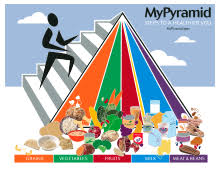
Still Lying to US
Following the release of the
Dietary Guidelines in April 2005, the USDA redesigned the food pyramid, which
stood more or less unchanged since its first appearance in 1992, and renamed it
“MyPyramid.” The pyramid is the visual representation of the 2005 guidelines;
it’s the main exposure most Americans get to the guidelines. The new design
turns the original pyramid on its side, dividing it into six different colored
sections representing the food groups: grains, vegetables, fruits, milk, meat
and beans, and oils.

The human figure climbing
stairs to the left of the pyramid illustrates the importance of exercise and
matches the slogan, “Steps to a Healthier You.” The design is colorful and
appealing, but the pyramid itself contains little information about how much to
eat. For instance, the vegetable section is about the same size as the milk
section. Does this mean that you should consume the same amount of milk and
vegetables?
My Pyramid’s advice from the
2005 Dietary Guidelines, shows some improvement from the previous pyramid. It
draws attention to both leafy green vegetables and whole grains, two groups the
old pyramid was missing. It addresses the concept of healthy fats with advice
to get most of your fat from fish, nuts and vegetable oils. For the first time,
beans, seeds and nuts are recognized as legitimate sources of protein, and the
pyramid even recommends “varying your protein routine and choosing more fish,
beans, peas, nuts and seeds.”
The milk section includes a comment for people
who “don’t or can’t consume milk,” marking the first time the USDA has
acknowledged that not everyone can digest dairy. Even with these advances, My Pyramid
is far from an easily understood, legitimate and accurate presentation of what
foods are necessary for health.
I believe no one diet is
right for everyone, and My Pyramid recognizes this fact by having the 12 different pyramids, depending on the
individual’s gender, age and activity level. To get specific instructions on the
appropriate amounts of food, you must visit the My Pyramid website. The link is: www.mypyramid.gov/
On the website, you are
asked to input personal information and then you are presented with “customized
recommendations”—one of 12 pyramids, with eating plans designed to cater to
individual needs. But a closer look reveals that the advice in each of the
pyramids is very similar: make half your grains *whole, vary your veggies, get
your calcium-rich foods, go lean on protein and limit calories from extra sugar
and fat.
The disparity is minimal,
missing the concept of different
diets for different people. How about a
pyramid for people on a vegetarian or vegan diet? Or what if the website asked
people if they felt better with more protein or more carbohydrates in their diet,
and then specified dietary advice based on that information?
My Pyramid also promotes the
idea that we can eat as much as we want, as long as we exercise every day.
Calories in, calories out is a concept that benefits both the food and the
exercise industries. The pyramid was constructed for people who exercise 30 to
60 minutes a day. A better plan would create a pyramid for people who do not
exercise at all, since that is what most Americans are doing.
The USDA still has a long
way to go before it can make real waves in the public’s understanding of how to
eat well. Directing people to a website for nutrition advice makes the issue
more complex than it needs to be. It is not difficult
to clearly state what foods are beneficial or detrimental to health, yet somehow
the USDA has missed the mark.
So much so that a Minnesota
couple created a spoof website, Mypyramid.org, poking fun at the USDA’s website
and its recommendations. Web designer Molly Nutting said she wanted to alert
people to the political and financial interests behind the food industry. The
site has since become the home of the Agribusiness Accountability Initiative,
tracking links between the food industry and the USDA.
Based on the publication, "Integrative Nutrition"
Based on the publication, "Integrative Nutrition"
Read in good health and
afterwards, “Get Up Get Moving” and remember,
“CHIT
CHAT WON”T BURN FAT”
No comments:
Post a Comment